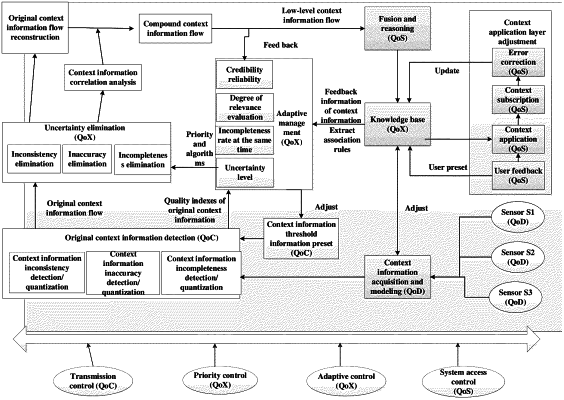| CPC G06N 5/04 (2013.01) [G06N 5/022 (2013.01)] | 10 Claims |

|
1. A context information uncertainty elimination system based on (Quality of comprehensive index) QoX adaptive management in heterogeneous context-aware networks, which comprises a sensor module, a context information acquisition and modeling module, a context threshold information preset module, an original context information detection module, an adaptive management module, an uncertainty elimination module, a context information correlation analysis module, an original context information flow reconstruction module, a composite context information flow module, a fusion and reasoning module, a context application layer adjustment module and a knowledge base;
wherein the sensor module, the context information acquisition and modeling module, the original context information detection module, the adaptive management module, the uncertainty elimination module, the context information correlation analysis module, the composite context information flow module, the fusion and reasoning module, the knowledge base and the context application layer adjustment module are connected in turn; the context threshold information preset module, the original context information detection module and the adaptive management module are sequentially connected from beginning to end; the adaptive management module, the uncertainty elimination module, the original context information flow reconstruction module and the composite context information flow module are connected in turn from beginning to end; the knowledge base is connected to the context application layer adjustment module;
the sensor module is related to Quality of Device (QoD) and utilized to collect context information;
the context information acquisition and modeling module is utilized to acquire context information and model the acquired context information according to the preset initial modeling method for obtaining original context information, and this module is related to the QoD;
the original context information detection module detects and quantifies the uncertainty of context information by calculating Quality of Context (QoC) indexes such as inconsistency rate, incompleteness rate, inaccuracy rate and timeliness, and combines the acceptance and rejection QoC threshold information preset by system to obtain the original context information flow that meets the requirements of system's accuracy rate and QoC indexes such as inconsistency rate, incompleteness rate, inaccuracy rate and timeliness; this module is related to the QoC;
the adaptive management module combines quality indexes of original context information, degree of relevance and feedback information of context information to evaluate the elimination priority level of each uncertainty factor of context information, and adaptively selects different elimination algorithms for a certain uncertainty problem in different situations, where quality indexes of original context information refer to inconsistency rate, incompleteness rate, inaccuracy rate and timeliness of the context information transmitted from the original context information detection module; degree of relevance refers to the correlation between the context information collected by each sensor in the sensor module and final judgment results; feedback information of context information comprises the user feedback information and the context information after context subscription and error correction; for the elimination priority level of uncertainty factors, the adopted principle is firstly to eliminate main contradiction, consider special circumstances into consideration and adopt a real-time feedback mechanism, this module is related to the QoX;
the uncertainty elimination module analyzes original context information and eliminates uncertain data of original context information, this module is related to the QoX;
the knowledge base is related to the QoX used to store the context information after fusion and reasoning, the information after context subscription information correction and user feedback information; meanwhile, the knowledge base provides context information modeling methods for the context information acquisition and modeling module, and adjusts context information acquisition threshold at the same time; it also provides feedback information and degree of relevance information between context information for the adaptive management module, and provides suitable fusion and reasoning mechanisms for the fusion and reasoning module;
the fusion and reasoning module is utilized to combine the data processed by the uncertainty elimination module, complete information flow reconstruction of original context information, analyze the correlation of context information and finally build information flow of compound context information with accurate data, clear structure and rich meaning; information flow of compound context information is fused and reasoned into the high-level context information that can be recognized by applications and smart devices through utilizing context information fusion and reasoning technologies, and then the high-level context information will be stored in the knowledge base; applications and smart devices make adaptive adjustments according to the high-level context information, this module is related to Quality of Service (QoS);
the context application layer adjustment module is used to adjust the operating statuses of programs or devices in real time according to user feedback or context subscription, and to update the historical context information in the knowledge base, this module is related to the QoS;
the context threshold information preset module is related to the QoC and utilized to preset the discarding threshold of context information;
the context information correlation analysis module is used to analyze the degree of relevance between context information;
the original context information flow reconstruction module is used to reintegrate original context information flow;
the compound context information flow module is utilized to reorganize context information based on the degree of relevance between context information, as well as the original context information after reconstruction.
|